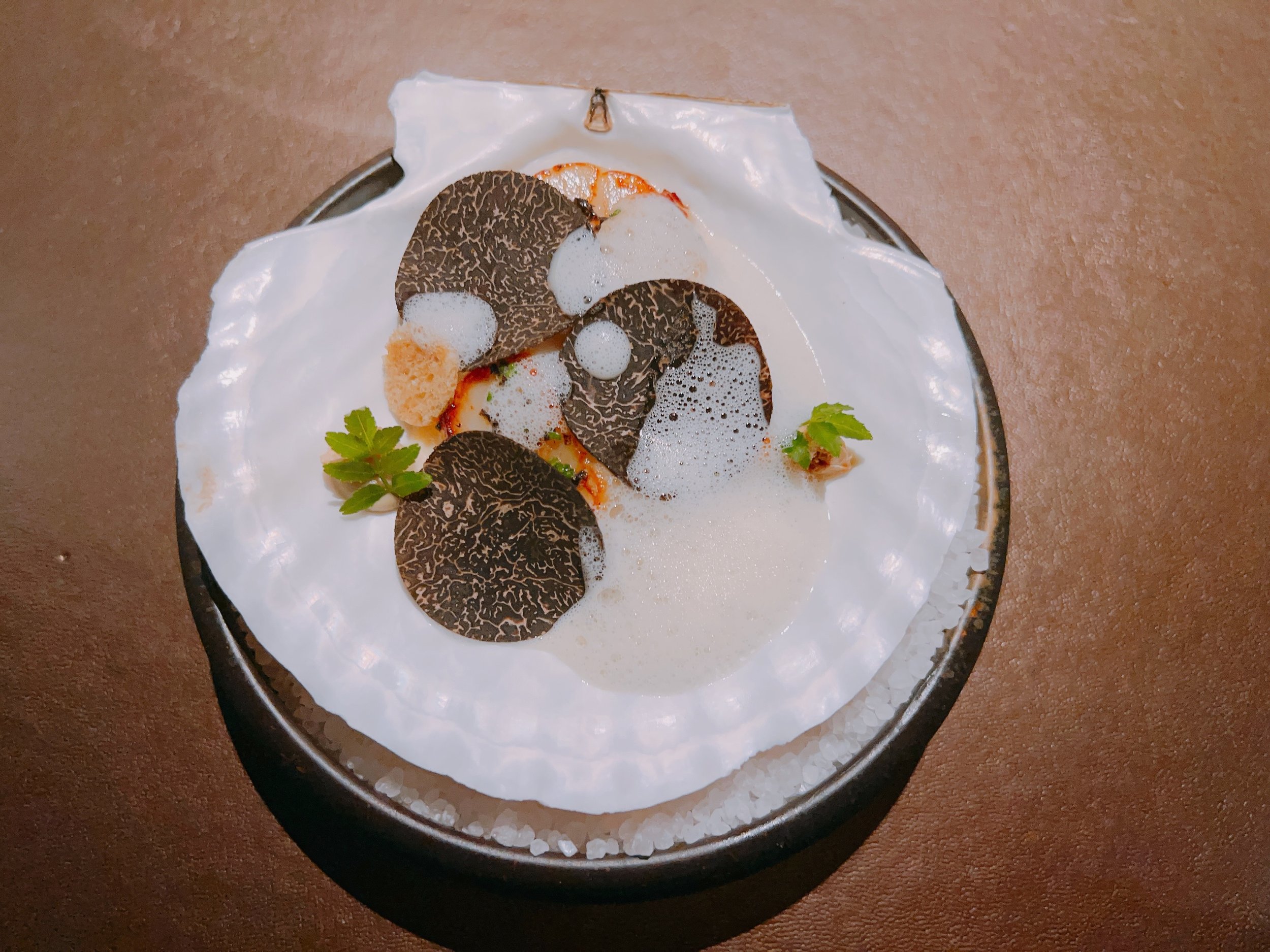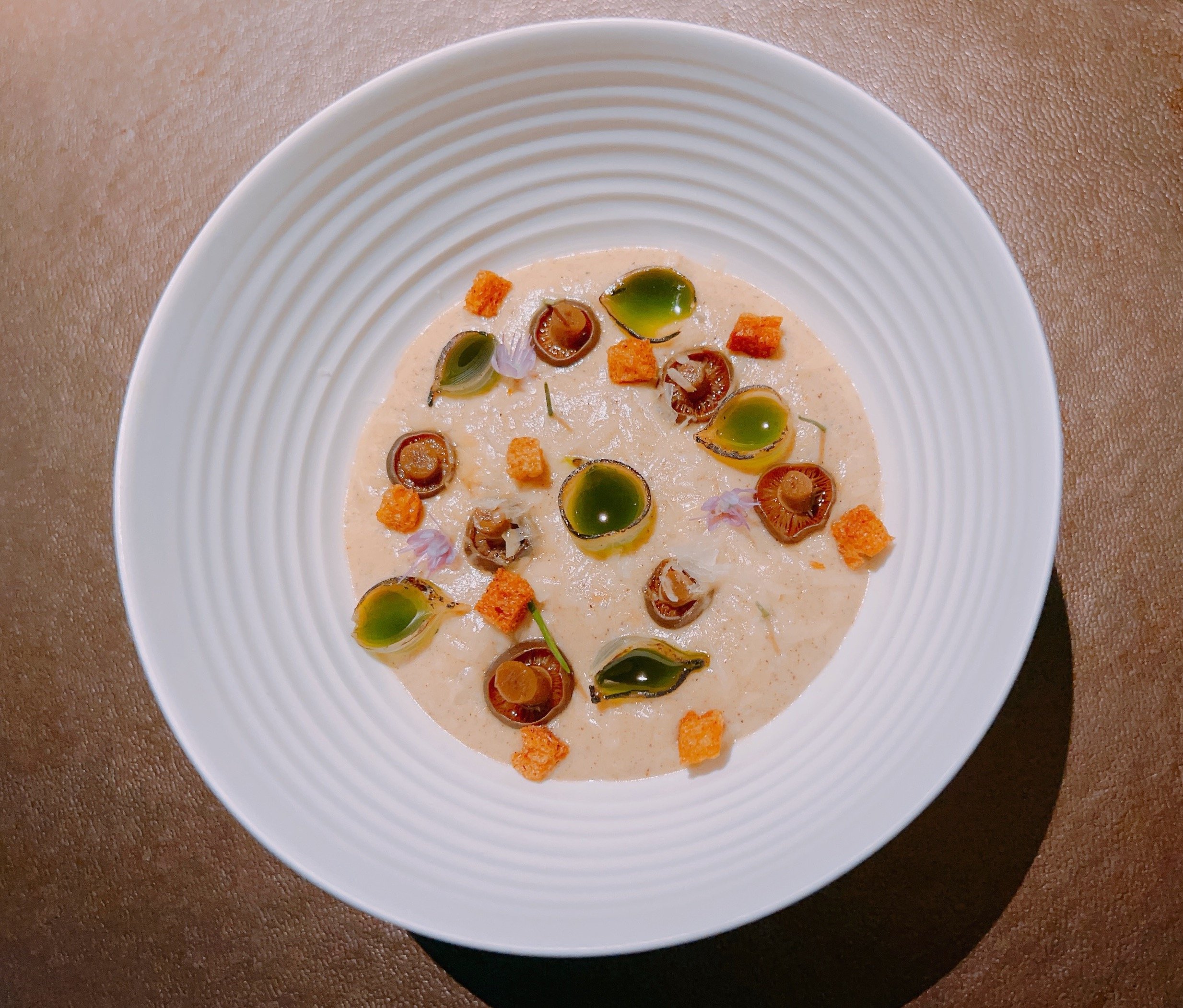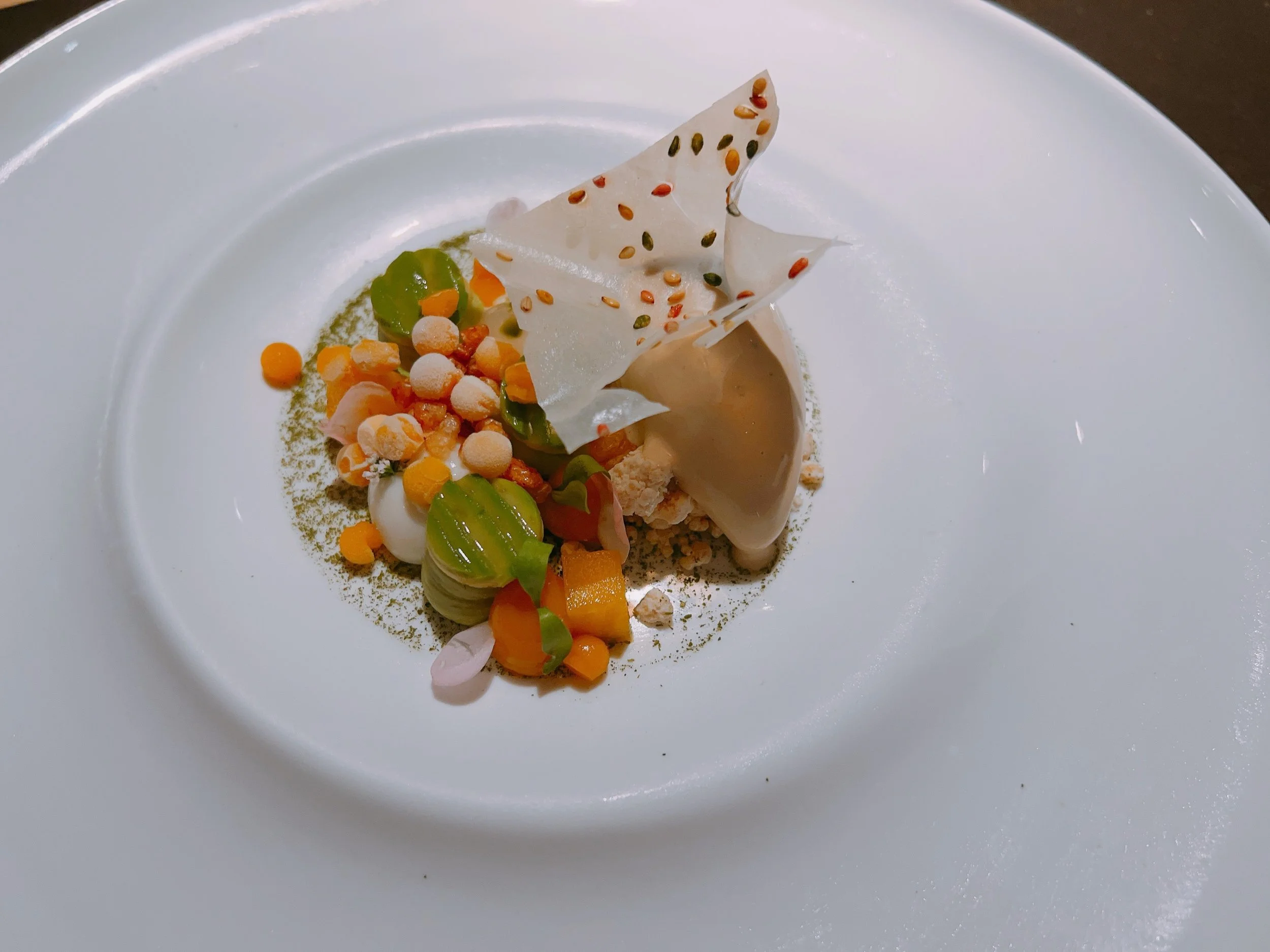Taian Table - Shanghai
Rating: 16/20
Where: Shanghai, China
When: Dinner for 2 on 28 July 2023
Cost per Person: Tasting menu 2588-2888 CNY, Wine pairing 1650-2180 CNY
Accolades: 3 Michelin Stars
Why: Western cuisine with interesting Asian influences, frequently changing menu
China charted its own course during the Covid pandemic, avoiding country-wide closures of restaurants as seen in the rest of the world. This allowed the Chinese Michelin Guides to keep on publishing without interruption. And not just that - two restaurants even jumped to three Michelin stars during that time. Unfortunately, unless one happened to live in China, visiting them was practically impossible until a few months ago. So here we were, with our still valid 10-year visas in hand and skirting a typhoon, finally able to make a tour of the three three-starred restaurants in China that we hadn’t been to yet. Coming from Hong Kong, our first stop was at “Taian Table” in Shanghai, which received its third star in late 2021.
Taian Table is located west of downtown Shanghai in a nondescript office complex. Not exactly a place where you (or our taxi driver) would expect to find a fine-dining restaurant. But I suppose it makes sense: the rent here is probably lower than in a glitzier location on the Bund, there is more space, and you're not really catering to walk-ins anyway - reservations generally have to be made weeks in advance. Interestingly, Shanghai’s other three star restaurant, Ultraviolet, is in an even more obscure location, so Taian Table is in good company.
Behind an unassuming door, the restaurant occupies a high-ceilinged space, with counter seats arranged in an U-shape around the open kitchen. In addition to the twenty or so counter seats, there are two tables of four somewhat removed from the action and (judging by the food carried out the door) a private dining room somewhere else in the building. The interior design is industrial chic - modern and a bit stark, with lots of black, some red, exposed concrete, and a wooden counter all around. While the chefs were cooking right in front of us, the vast majority of our interactions were with the serving staff. Everyone spoke excellent English.
The restaurant is open only for dinner, and serves a single tasting menu to all customers. The tasting menu changes every 6-8 weeks, and we were here for edition number 42. The answer to the ultimate question of fine dining? We were about to find out. In addition to the fixed eight-course tasting menu, one was required to order 2-4 more dishes from a second, additional menu, which featured a mix of classics and newer creations. Dietary restrictions were accommodated: in our case a pescatarian menu was created by replacing two courses with choices from the second menu. Between the two of us, we tried all sixteen dishes available on the regular and the extended menus.
Two wine pairings were offered: one consisted solely of German wines, the other (slightly more expensive) pairing featured mostly French wines. Why German? The chef was born in Germany and started his culinary career there, but he has been living and cooking in Shanghai for almost twenty years. Most of the culinary staff similarly hailed from Europe, so it's no surprise that the cuisine served here, while having some Asian influences and ingredients, was decidedly Western. Back to the wine pairings - they were decent, but not exceptional. The German wines were all dry except for the dessert wine; none of the off-dry Rieslings that Germany is so (in)famous for. Quality-wise, the two pairings were pretty close to each other, so that the German pairing might actually the better deal, especially since it included some grape varieties such as Gutedel that are rarely seen outside of Germany. Worth a try.
Our dinner started the second we sat down, before we had even seen a menu or ordered a drink. In quick succession, we were served candied, slightly salty macadamia nuts 17, and seaweed and Parmesan crackers. The latter reminded me a bit of cheesy papadams 16. My wife was blown away by the seaweed crackers, and would have given them a 19. A beverage made with fermented plums, jasmine and chamomile was served as well - a light, slightly sweet welcome drink 16.
While we were still pondering our dinner choices, even more appetizers appeared. I don't know whether being bombarded with food was due to us arriving late for our reservation (thanks to Shanghai's slow-moving rush-hour traffic), or was simply the restaurant's customary way of welcoming hungry diners. In any case, we felt a bit rushed at the beginning of our night. Thankfully, the pace slowed down over the course of our dinner, which clocked in at around four hours - a reasonable length for such a tasting menu.
Back to the rapid-fire appetizers. The next one was described as the restaurant's take on the Indian street food classic of pani puri. A chickpea cracker shell was filled with peanuts, little balls of mango and avocado as well as a sphere filled with liquid: papaya and mango juices. Eaten in one bite (to avoid a messy spillage), this was actually quite nice. While it had a hint of spiciness, the main taste was of fruit. In that, it was a very liberal interpretation of a pani puri, both sweeter and fruitier - I would not have made the connection had I not been told about it. Other than wishing that the cracker was a bit crunchier, this was pretty good 17.
A trio of appetizers came next, to be eaten in ascending order on a staircase. (We later discovered that the kitchen was quite fond of serving things in threes.) A cracker shell was filled with sweet peas, 18-months-aged cheese and a fresh mint cream. The dish was surprisingly light on pea flavor, the peas used here resembled lentils in texture 15. Better was a dried sunchoke shell filled with mushrooms, pine nuts and berries. It reminded me of a “forest”, the flavors and different textures were distinctive, but also complemented each other well, some were sweet, some less so, some softer, some more chewy - very nice 17. My wife was more blown away by this dish and rated it a 19. Finally, a seaweed tartlet was filled with a mix of two tartares - toro tuna and veal tenderloin - and finished with some caviar. The shell was very light, and the contents burst with flavor - excellent! The veal and tuna went so well together than I couldn't tell them apart 19.
The last appetizer was a warm, fluffy egg custard served in an egg shell. It was topped with corn and a little piece of foie gras. A pleasant dish, but also a bit boring. The egg was decent with a nice mousse-like consistency, but the corn and foie gras didn't add anything revelatory to it 14.
The official first course of the tasting menu was billed as a “smoked eel”. And while the dish did in fact contain smoked eel, it was also a tour de force preparation of potatoes and leeks. These two appeared as a mousse at the bottom of the dish, as crispy fried threads on top of the eel, and as a clarified consommé of potato leek soup. Oils of chives and burnt beets were added for flavor, and a dollop of caviar capped the presentation. This was the kind of dish best eaten after mixing all components - the flavors and textures complemented each other nicely, with the nicely prepared eel being the most prominent. I was happily surprised that the dish was neither very salty (given the caviar), nor particularly heavy for being potato based. But the preparation seemed quite complicated for the simple taste it ultimately delivered: smoked eel with potatoes and leeks 17.
Two dishes from the extended menu came next. Sea urchin (uni) was served on a sourdough bread with an oyster mayonnaise and a slice of green apple. The creamy uni and the soft chewy bread went nicely together. Pleasant, but a bit subdued flavorwise 16.
Osetra caviar was served in a cup made from pickled beets and surrounded by an almond “gazpacho”. The beets were crunchy and slightly sweet, whereas the soup was a bit gritty thanks to the ground almonds. Unfortunately, the beets were so strong in flavor that they overpowered the caviar, which was supposed to be the star of the dish 15. My wife was slightly more appreciative, rating this a 16.
Next, a beef tartare served “Korean style”: in a cracker with some egg yolk, mustard seeds, and gochujang, a spicy Korean condiment. A very nice combination - a bit spicy, with several creamy ingredients, and feeling relatively light. A kimchi broth that was provided in a separate glass as a palate cleanser was exceptionally good - sour and spicy 17.
The pescatarian replacement of the beef was torched aji (horse mackerel) served with pickled radishes, cucumbers, shiso leaves and a shiso leaf broth. This broth was very good, a bit sweet and full of flavor. The fish was unfortunately much lighter in comparison, a slightly stronger taste might have stood up better to the broth 16. My wife liked this dish much more, rating it a 17 or 18.
Seared Hokkaido scallops were served with Australian winter truffles - the latter incorporated into the dish as well as shaved on top. Also present were salted artichokes, an artichoke puree, sourdough chips, roasted and chopped hazelnuts, and a shio koji beurre blanc. The law of threes applied: three pieces of scallops, three slices of truffles, three sourdough chips. The scallops were cooked very nicely, the sauce was tasty, and the hazelnuts added some welcome texture. The downsides: unexpectedly, there was not much of a truffle flavor, and the sourdough chips were soggy by the time we got to them 17.
Lightly cured and then torched carabineros shrimp together with pickled pumpkins (three pieces each, again) were served in a bisque of carabineros and ginger. A tomato chutney was incorporated into the dish as well. This chutney was the culinary bridge to a side of lentil “dosas” that were filled with a masala of pumpkins and pumpkin seeds. The shrimp were soft and cooked perfectly, and the sauce was very flavorful. The dosa was also good, but was only a loose reinterpretation of the classic South Indian dish. Its texture was more similar to a cracker, and the filling was much more finely ground than it would be in a “real” dosa 16. My wife liked this dish, especially the shrimp part, a lot and would have given it an 18.
A poached turbot was served two ways: half as a filet and half as a “fish cake” made of minced fish and mushrooms. It came with various mushrooms, some bacon, kombu oil and a seafood/mushroom broth made from several dried ingredients: scallops, porcinis, shiitake, trumpet mushrooms, chanterelles and kombu seaweed. I loved the broth, it was full of flavor and a bit sweet, and integrated the different ingredients very well - neither seafood nor mushrooms were too prominent. The mushrooms were equally amazing (18 or 19 for them and the broth). The fish and fish cake, however, felt a bit bland; they were the weakest part of the dish 17.
Two more optional dishes came next. A mousse of “burnt onions” was actually made from shallots, and topped with pickled onions, kohlrabi, shimeji mushrooms and small croutons. I quite liked the toppings, the sourness of the pickles went well with the light, umami-full mousse. By itself, the mousse seemed a bit too plain 16.
New Zealand lamb was served with lamb jus, chanterelles, asparagus, peas and a potato millefeuille. Our server told us that this meat was bred to be the lamb equivalent of wagyu. And it was indeed quite nice - juicy and flavorful, much better than what we had the previous night in Hong Kong. The lamb fat had been prepared separately and then reunited with the meat on our plate. A very nicely done execution. Less successful were the sides: the peas were good, the asparagus ok, but the potatoes were entirely unseasoned and tasted of close to nothing - hard to admit for someone who loves potatoes. In the end, the lamb carried the dish 17.
Next, a palate cleanser. Mangosteen came from fifty year old trees in Thailand. It was prepared in three different ways: as a fruit, as an elderflower/mangosteen sorbet and as a mangosteen/moscato foam. A simple, sweet, fruity, light dish 16.
At first, I was puzzled why such a sweet dish would be served between two savory dishes that didn't have that terribly different flavor profiles (the lamb and the following pigeon). But looking at the base tasting menu, this bridge would have been from the turbot to the pigeon, two much more dissimilar dishes. I guess that's the difficulty of designing a course progression when the diner is able to order additional dishes that might upset that order…
The savory main course of pigeon arrived soon after the palate cleanser. Sourced from close to Shanghai, the pigeon had been dry-aged and was served with a charred waxberry sauce. On the side: sunchokes and swiss chard, as well as a separate bowl containing waxberry foam, pigeon liver, a ravioli filled with pigeon thigh, apples and salted cabbage. I was happy to discover that the waxberry sauce was savory and slightly acidic rather than fruity, as the word “berry” might have suggested. The pigeon was ok, but didn't impress me as much as the earlier lamb. Better were the nicely salted and flavor-intense sunchokes. The dumpling was ok, but unfortunately only lukewarm by the time I got to it 16.
Instead of the pigeon, the pescatarian menu featured a grilled Alaskan king crab leg that was seasoned with lime and lemon peel, and served with pickled watermelon radishes and a white miso and seaweed hollandaise. The crab together with the hollandaise were fine, but not particularly revelatory. The crunchy radishes felt too sweet for this dish 16.
On to dessert, first with two choices from the optional menu. Cream cheese seasoned with umeboshi came with merengues, frozen berries and matcha powder. Essentially this was a cheese cake without the cake: sweet and heavy. The berries added some fruitiness, which made this a tasty, though presumably not low-calorie, treat. Nothing wrong with a good cheese cake, but a bit more complexity would have been nice 16.
Roasted rice gelato was served with lots of sides: a rice cracker, sesame seeds, fresh mango cream, frozen avocado cream, avocado slices, breadcrumbs, coriander powder, and probably more things that I missed. I loved the sweet gelato (18 by itself). The other components tended to be more on the savory side, and fell more in the “interesting” or “liked them” categories, rather than the “loved them” one. Less might have been more here 16.
The only dessert from the main tasting menu came next. Cubes of caramelized pineapple were served on top of a brioche, and paired with a coconut/pineapple gelato and a panna cotta. The coconut/pineapple combination was wonderful, the brioche added some good crunch, and the caramel went wonderfully with the paired Sauternes (from the non-German wine pairing). My favorite among the desserts 17.
Some petit fours followed. A small tarte was introduced as a “peach baba” and contained a peach liquor puree. To me, this felt more like a chocolate cake than a traditional rum-soaked baba 14. A passion fruit/coconut/hazelnut bonbon (with a smiley face) was very nice: the first impression was of fruit, which then changed to a more nutty flavor 16. What looked like a cherry was actually a cherry chocolate cake - even the stem was edible. This bite tasted (too) strongly of cherry flavor, and wasn't very sweet, the flavor balance felt a bit off 13. Finally, a “canele” was more like a canale cracker. It had a very, very crunchy shell, probably too crunchy, and very little of the usual moist interior 14.
Next, a round of chocolates. An almond liquor chocolate was mostly just chocolate and had only a hint of almond flavor 15. Next to it was a Lego figurine-shaped chocolate flavored with coffee, dried watermelon and pop rocks. I assume the pop rocks and the Lego toy have the common theme of being childhood favorites? Similar to the other praline, this was predominantly chocolate, and the watermelon flavor was hard to detect 14.
Finally, five more choices of chocolate pralines. From top to bottom in the picture: rosemary/apricot was stronger on the herb than the fruit 15. A sea salt/caramel filling was more buttery than caramelly, and not too sweet 15. The yuzu praline was unfortunately quite light on the yuzu flavor 13. A beetroot praline tasted indeed somewhat of beetroot - unusual and my favorite of the five 16. Mojito was very sour and fizzy, quite different from the other pralines and probably best eaten last 14.
Overall: An enjoyable dinner of French cuisine that incorporated Asian ingredients and took inspirations from Asian cuisines (Indian and Korean in particular). What puzzles me a bit is that I wasn't more wowed by the dishes. Clearly, lots of care and culinary technique went into their preparation, and most of them sounded great on paper. But I was missing the stand-out, popping flavors that I usually associate with Western three-star cuisine. My wife was consistently more upbeat about the dishes, so this might warrant a revisit. And then we can try an entirely new menu 16.


























